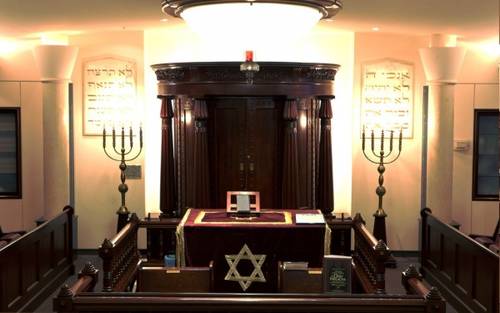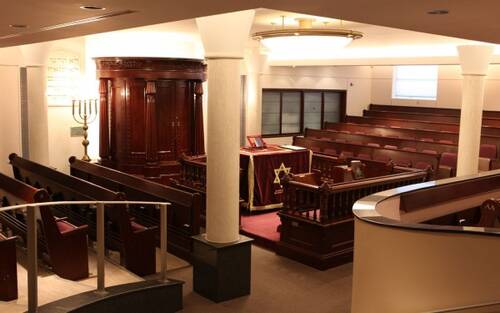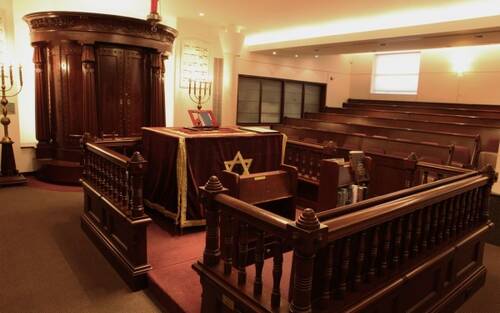PARACHAT CHLAH LEKHA – 29 JUIN 2019/26 SIVAN 5779
PETIHAT HAHEKHAL : Edmond Guindi
Chabbat Mébarkhim le mois de Tammouz :
Roch Hodech Tammouz : Mercredi et jeudi 3 et 4 juillet
Dans ce bulletin/ In this issue
La Paracha en bref
Le Tsitsit –franges
The breaded Challah
Le mois de Tammouz
Nostalgie du Liban- prières
Shlach Lecha Quiz
Proverbes
The Shabbat smile
Chela'h Lekha - en bref
Nombres 13, 1 - 15, 41
Moïse envoie douze espions en Canaan. Ils sont de retour quarante jours plus tard porteurs d’une grappe de raisins, d’une grenade et d’une figue qui témoignent de la générosité de la terre.
Mais dix d’entre eux ajoutent que ses habitants sont des géants, qu’ils seraient des combattants « plus forts que nous » ; seuls, Caleb et Josué plaident pour que la terre de Canaan soit conquise suivant l’ordre de D.ieu.
Le peuple se plaint, semblant préférer le retour en Egypte. D.ieu décrète alors que l’entrée d’Israël en Terre Promise sera retardée de quarante ans, temps pendant lequel toute la génération s’éteindra. Pris de remords, un groupe de Juifs attaque, contre la volonté de Moïse, la montagne qui borde la frontière : il est défait par les Amalécites et les Cananéens.
Les lois des ména’hot (les donations de fleur de farine mélangée d'huile) et des libations de vin sont données ainsi que le commandement de consacrer à D.ieu une portion de la pâte (la 'hallah), lorsque l’on fait le pain.
Un homme viole le Chabbat en ramassant du bois : il est mis à mort. D.ieu ordonne de placer des franges (tsitsit) aux quatre coins de nos vêtements pour qu’elles nous soient un rappel d’accomplir Ses commandements, les Mitsvot.
© Copyright, all rights reserved. If you enjoyed this article, we encourage you to distribute
Tsitsit - Les franges
Le Judaïsme représente plus qu’une frange de la population : c’est notre uniforme. Sous leur chemise, les hommes et les garçons juifs portent un poncho appelé talith katan (littéralement : petite cape), avec des franges qui pendent aux quatre coins, tel que le prescrit la Torah (Nombres 15, 37-40) : « Ils feront des franges aux coins de leurs vêtements... »
Ces franges, appelées tsitsit, sont enroulées et nouées de manière à nous rappeler toutes les mitsvot. La valeur numérique des lettres hébraïques qui forment le mot tsitsit donne une somme de 600. Ajoutez-y les huit fils et les cinq nœuds de chaque tsitsit, et le total est 613. Vous comprenez à présent pourquoi il est de coutume de laisser pendre les tsitsit à la ceinture, de manière visible. Avoir un rappel tangible des mitsvot renforce notre capacité à contrôler les élans de notre cœur.
Seuls les vêtements présentant quatre coins doivent avoir des tsitsit. Or, peu de vêtements de nos jours (hormis les ponchos) ont quatre coins, c’est pourquoi nous portons spécialement un talith à quatre coins pour pouvoir accomplir cette mitsva. Lors des prières du matin, les hommes portent un talith gadol, qui est une version plus grande du talith katan
Traditionnellement, chez les sépharades du Moyen Orient, un garçon peut porter un Talit même avant sa Bar Mitzvah.
THE CHALLAH
The braided challah , which is made with eggs, is the Jewish Sabbath‑and‑holiday bread. It is surrounded by folklore and tradition and loaded with symbolism. On festive occasions a blessing is said over two loaves, symbolizing the two portions of the manna that was distributed on Fridays to the children of Israel during their Exodus from Egypt.
The breads are covered on the table by a decorative challah cover or a white napkin, which represents the dew that collected on the manna in the morning. Poppy and sesame seeds sprinkled on the bread also symbolize the manna that fell from heaven.
Challah is made in various sizes and shapes, all of which have a meaning. Braided ones, which may have three, four, or six strands, are the most common, and because they look like arms intertwined, symbolize love. Three braids symbolize truth, peace, and justice. Twelve humps from two small or one large braided bread recall the miracle of the 12 loaves for the 12 tribes of Israel. Round loaves, where there is no beginning and no end, are baked for Rosh Hashanah to symbolize continuity. Ladder and hand shapes are served at the meal before the fast of Yom Kippur, the ladder signifying that we should ascend to great heights, the hand that we may be inscribed for a good year. On Purim, small triangular loaves symbolize Haman’s ears; at Shavuot, two oblongs side by side represent the Tablets of the Law (the 10 commandments). The bulkah is a segmented rectangular challah. Sweet challahs with honey or raisins are baked during the festive season to bring joy and happiness. The name challah is derived from the Hebrew word used for portion in the biblical commandment of the first of your dough you shall give unto the Lord a portion for a gift throughout your generations. Jews were biblically commanded to separate from their doughs one twenty‑fourth and give it to the kohanim (priests) every Sabbath.
Challah is made in various sizes and shapes, all of which have a meaning. Braided ones, which may have three, four, or six strands, are the most common, and because they look like arms intertwined, symbolize love. Three braids symbolize truth, peace, and justice. Twelve humps from two small or one large braided bread recall the miracle of the 12 loaves for the 12 tribes of Israel. Round loaves, where there is no beginning and no end, are baked for Rosh Hashanah to symbolize continuity. Ladder and hand shapes are served at the meal before the fast of Yom Kippur, the ladder signifying that we should ascend to great heights, the hand that we may be inscribed for a good year. On Purim, small triangular loaves symbolize Haman’s ears; at Shavuot, two oblongs side by side represent the Tablets of the Law (the 10 commandments). The bulkah is a segmented rectangular challah. Sweet challahs with honey or raisins are baked during the festive season to bring joy and happiness. The name challah is derived from the Hebrew word used for portion in the biblical commandment of the first of your dough you shall give unto the Lord a portion for a gift throughout your generations. Jews were biblically commanded to separate from their doughs one twenty‑fourth and give it to the kohanim (priests) every Sabbath.
Taking Challah
In post-Temple times the rabbis ordained that a challah (portion), which had to be at least the size of an olive, must be separated from the dough and burned. It is still a tradition for Jewish bakers and observant homemakers to tear a tiny lump of risen dough from any type of bread and to burn it (usually wrapped in foil) in the oven or fire while making a blessing
LE MOIS DE TAMMOUZ
Ce mois est nommé d’après l’antique dieu du soleil babylonien (Ezéchiel 8:12–18).
En prenant Nissan pour le premier mois de l’année, Tamouz en est le quatrième. Nous n’attendons aucune fête pour réjouir nos cœurs et nos êtres mais, au contraire, nous savons que dans notre histoire au cours de Tamouz ont eu lieu des événements fâcheux qui se sont poursuivis dans le premier tiers du mois suivant.
Cependant, avant que d’évoquer le caractère éprouvant de ce qui eut lieu le 17 de Tamouz, nous évoquerons le fait historique du 3 Tamouz, lorsque les Amoréens attaquèrent les Enfants d’Israël et que Josué qui était à la tête du peuple d’Israël vit qu’il manquerait de temps pour les vaincre et, alors, il saisit son glaive et le brandit en direction de la lune et du soleil en priant D d’arrêter leur course pour permettre au peuple de vaincre son ennemi et le soleil interrompit sa course !
Le départ en mission des explorateurs s’est opéré à Roch Hodesch Tamouz et a duré quarante jours. Leur retour de cette expédition a lieu le 9 Av, voila pourquoi cette date est resté pour Israël une date douloureuse jusqu’à ce jour.
Le 9 tamouz de l’an -586, les armées de Nabuchodonosor pénétrèrent dans la ville sainte laissant ainsi présager du désastre qui surviendrait un mois plus tard.
Nostalgie du Liban –
Prières de motsaé Chabbat (fin du Chabbat) chanté à Holon selon le Minhag libanais.
Ouvrez : https://youtu.be/a4wCJaPXT4o
|
Shelah Lecha Quiz
|
1) Q. Why is the portion about the spies written immediately after the portion about Miriam's having Tzara'at?
|
A. To show the foolishness of the Meraglim (spies), that they saw Miriam punished for speaking Lashon Hara (slander) and didn't learn a lesson from her. They spoke Lashon Hara about the land.
|
2) Q Which fruit did the Meraglim bring back from Eretz Yisrael?
|
|
Shelah Lecha Quiz
|
1) Q. Why is the portion about the spies written immediately after the portion about Miriam's having Tzara'at?
|
| |
|
|
|
|
Shelah Lecha Quiz
1) Q. Why is the portion about the spies written immediately after the portion about Miriam's having Tzara'at?
A. To show the foolishness of the Meraglim (spies), that they saw Miriam punished for speaking Lashon Hara (slander) and didn't learn a lesson from her. They spoke Lashon Hara about the land.
2) Q Which fruit did the Meraglim bring back from Eretz Yisrael?
A. A cluster of grapes, a pomegranate and a fig.
3) Q. How many men were needed to carry the cluster of grapes?
A. The midrash states that it was so heavy that they needed eight people to carry them. One spy held a huge pomegranate and one spy held a huge fig.
4) Q. Which of the Meraglim returned empty handed?
A. Yehoshua and Caleb. They knew the other spies were bringing back the fruit with bad intentions. They wanted to show the people, that just as the fruit in Israel were huge, the people dwelling there were also huge and too strong to conquer.
5) Q. Why did Hashem shorten the journey of the Meraglim?
A. The midrash teaches that Hashem knew that the Jewish People would sin on account of the Meraglim and would spend a year in the Midbar for every day of the mission (forty days - forty years). Therefore, Hashem shortened the journey to soften the decree against the Jewish People.
The main reason why Hashem chose forty years was because Hashem said that everyone who was twenty years old and older would die in the wilderness and not enter Israel. The punishment was that they should die in the wilderness; not that they should die prematurely. So, to give the youngest ones, the twenty year olds, a chance to live till sixty (average life expectancy at the time), it would take forty years.
6) Q. With which true statement did the Meraglim begin their evil report?
A. That Eretz Canaan is a land flowing with milk and honey.
7) Q How did Caleb quiet the people?
A. He fooled them by shouting, "Is this all that Moshe did to us?" The people quieted themselves to hear what further disparagement Caleb wished to add.
8) Q. Why did the Land appear like a "land that eats its inhabitants"?
A. Hashem caused many deaths among the Canaanites so that they would be preoccupied with burying their dead and not notice the Meraglim (spies).
9) Q. On which date did the Bnei Yisrael cry because of the report of the Meraglim? How did this affect the future of the Jewish Nation?
A. The Midrash teaches us that this event took place on Tisha B’Ab. Five terrible things are recorded happening on Tisha B’Ab. First was the sin of the spies recorded in today’s parasha. Next, the two Temples were destroyed on this date. Fourth, Betar, the last fortress against the Romans during the Bar Kochba revolt succumbed to the enemy (year 135CE. ). Fifth, the Temple area was plowed (year 136). More recently it is reported that the final expulsion date of Jews from Spain was August 3, 1492 which was also Tisha B’Av, and that World War I began on Tisha B’Av (August 2, 1914 was Tisha B’Av and the day the Germans gave Belgium an ultimatum, leading to German invasion of Belgium on August 4, 1914) which led to WWII and the Holocaust.
10) Q. Caleb and Yehoshua praised Eretz Canaan and tried to reassure the Jewish People that they could be victorious. How did the Jewish People respond?
A. The Jewish People wanted to stone them.
11) Q. "How long shall I bear this evil congregation (14:27)?" Hashem is referring to the ten Meraglim who slandered the Land. What important concept do we learn from this verse?
A. That ten men are considered a congregation, and since prayers of Kedusha (Kadish, Kedusha, etc.) require a congregation, ten men are required.
12) Q. Which two locations were named for events which occurred in parashat Shelah?
A. Nachal Eshkol, because of the cluster of grapes taken there and Chormah, because of the destruction that occurred there.
13) Q. How is the Mitzvah of Challah different from other Mitzvot that are associated with Eretz Yisrael?
A. The obligation to observe other Mitzvot associated with Eretz Yisrael began only after the possession and division of the Land. The obligation to observe the Mitzvah of Challah started immediately upon entering the Land. Also, because of the wording of verse 18, the Shulchan Aruch (based on Maimonides and the Talmud) writes that if one were to take wheat or fruits from Israel to the diaspora, they do not require Hallah, teruma, or ma’aser (tithes) even if they are Israeli produce. Please consult your local rabbinic authority before eating.
PROVERBES
On est soi-même que dans son propre pays
Le travail fait de l'homme un homme
Le renard qui dort n'attrape pas de poule
Un œuf pourri gâte toute la bouillie.
Ce que la bouche prend pour mâcher, l'estomac doit le digérer.
Chacun pense que son coucou chante mieux que le rossignol des autres
Où l'on dit père et mère, on entend les noms les plus agréables
Dieu donne les épaules suivant la charge
L'envieux est son propre bourreau
.Tout ce qui n'est pas donné de bon cœur perd son mérite ; fût-ce une rose, elle n'a plus de parfum.
Écouter, c'est apprendre ; se taire, c'est conserver.
THE SHABBAT SMILE
Doctor, I'm getting ever more forgetful, what should I do?"
Doctor: "Pay me in advance."
Hershel feels that he's not getting enough Aliyahs, and so he goees in to see the Rabbi.
He wants to become a Kohain.
Although reluctant, the Rabbi, after much persuasion and arm twisting, finally agrees to the request. But on one condition.
"They know you here. You must move to another Congregation where no one will know your prior status." Hershel agrees to the condition, and moves to another Congregation. On his first Shabbos there, right before Torah Reading, the Parnass (Gabbai) comes up to greet Hershel, and to welcome the new face.
"By the way", continues the Gabbai, "are you a Kohain?".
"Absolutely" came the answer.
"In that case," replied the Gabbai, "I would like to respectfully request that you leave the room for a few moments. We have some yarzeits and need the Kohain aliya!"
The most remarkable thing about my mother is that for thirty years she served the family nothing but leftovers. The original meal has never been found."
A Jewish patriarch was on the witness stand.
"How old are you?" asked the District Attorney.
"I am, kayn aynhoreh, eighty-one."
"What was that?"
"I said, I am, kayn aynhoreh, eighty-one years old."
"Just answer the question!" yelled the D.A., "How old are you!?"
"Kayn aynhoreh, eightly-one." the old man replied.
The judge said, "The witness will answer the question & only the question or
be held in contempt of court!"
The counsel for the defense rose and asked the judge, "Your Honor, may I
ask?"..and turned towards the old man, "Kayn aynhoreh, how old are you?"
The old man replied, "Eighty-one"
A pious man who had reached the age of 105 suddenly stopped going to synagogue.
Alarmed by the old fellow's absence after so many years of faithful attendance the Rabbi went to see him. He found him in excellent health, so the Rabbi asked, "How come after all these years we don't see you at services anymore?" The old man looked around and lowered his voice. I'll tell you, Rabbi," he whispered. "When I got to be 90 I expected G-d to take me any day. But then I got to be 95, then 100, then 105. So I figured that G-d is very busy and must have forgotten about me ..... and I don't want to remind Him.
CHABBAT CHALOM
MAGHEN ABRAHAM
David Hasson






